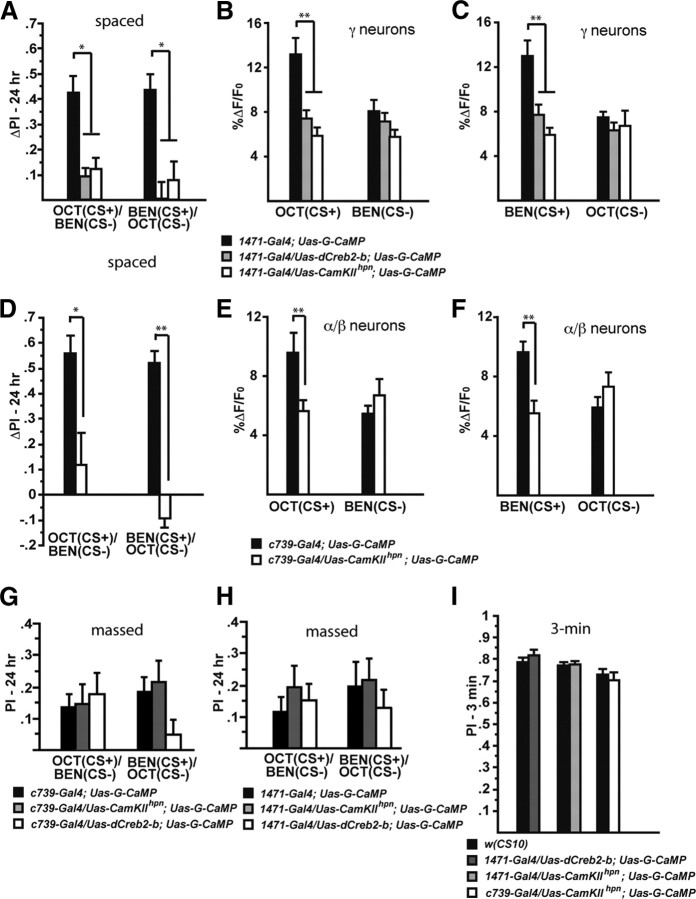Figure 5.
The long-term memory trace in the axons of γ MB neurons is disrupted by expression of a Creb repressor and a CaMKII hairpin RNA. A, Expression of dCreb2-b or CaMKII hairpin RNA in neurons defined by 1471–Gal4 impairs long-term behavioral memory after spaced forward conditioning. Flies carrying Uas–dCreb2-b, Uas–G-CaMP, and 1471–Gal4 showed significantly reduced performance scores for both Oct (CS+) and Ben (CS+) compared with control flies carrying only Uas–G-CaMP and 1471–Gal4 (Mann–Whitney pairwise comparisons, p ≤ 0.0209). Similarly, flies carrying Uas–CaMKIIhpn, Uas–G-CaMP, and 1471–Gal4 showed significantly reduced performance scores for both odorants as the CS+ compared with the control flies (Mann–Whitney pairwise comparisons, p ≤ 0.0047; n = 12 for all groups). Error bars are the SEM. *p < 0.05. B, There was a significant difference in the measured calcium trace (%ΔF/F0) in response to Oct (CS+) 24 h after spaced forward conditioning between flies carrying only the expressed reporter (1471–Gal4; Uas–G-CaMP) and flies that carried the expressed reporter along with Uas–dCreb2-b or Uas–CaMKIIhpn (Kruskal–Wallis statistic of 16.401, p = 0.0003; Mann–Whitney pairwise comparisons, p ≤ 0.0057). There was no significant difference in response to the CS− among the genotypes (Kruskal–Wallis statistic of 2.856, p = 0.2398; Mann–Whitney pairwise comparisons, p ≥ 0.1391; n = 12–20 for all groups). Error bars are the SEM. **p < 0.01. C, There was a significant difference in the measured calcium trace (%ΔF/F0) in response to the CS+ (Ben) 24 h after spaced forward conditioning between flies carrying only the expressed reporter (1471–Gal4; Uas–G-CaMP) and flies that carried the expressed reporter along with Uas–dCreb2-b or Uas–CaMKIIhpn (Kruskal–Wallis statistic of 15.252, p = 0.0005; Mann–Whitney pairwise comparisons, p ≤ 0.0082). There was no significant difference in response to the CS− among the genotypes (Kruskal–Wallis statistic of 2.279, p = 0.3199; Mann–Whitney pairwise comparisons, p ≥ 0.1872; n = 10–12 for all groups). Error bars are the SEM. **p < 0.01. D, Expression of CaMKII hairpin RNA in neurons defined by c739–Gal4 results in the abolishment of long-term behavioral memory after spaced forward conditioning. Flies carrying Uas–CaMKIIhpn, Uas–G-CaMP, and c739–Gal4 showed significantly reduced performance scores for both Oct (CS+) and Ben (CS+) compared with control flies that carry only Uas–G-CaMP and c739–Gal4 (Mann–Whitney pairwise comparisons, p ≤ 0.0105; n = 6–12 for all groups). Error bars are the SEM. *p < 0.05, **p < 0.01. E, There was a significant difference in the measured calcium trace (%ΔF/F0) in response to the CS+ (Oct) 24 h after spaced forward conditioning between flies carrying only the expressed reporter (c739–Gal4; Uas–G-CaMP) and flies that carried the expressed reporter along with Uas–CaMKIIhpn (Mann–Whitney test, p = 0.0003). There was no significant difference in response to the CS− among the genotypes (Mann–Whitney test, p = 0.1914; n = 10–12 for all groups). Error bars are the SEM. **p < 0.01. F, There was a significant difference in the measured calcium trace (%ΔF/F0) in response to the CS+ (Ben) 24 h after spaced forward conditioning between flies carrying only the expressed reporter (c739–Gal4; Uas–G-CaMP) and flies that carried the expressed reporter along with Uas–CaMKIIhpn (Mann–Whitney test, p = 0.021). There was no significant difference in response to the CS− among the genotypes (Mann–Whitney test, p = 0.7416; n = 9–10 for all groups). Error bars are the SEM. **p < 0.01. G, Expression of dCreb2-b or CaMKII hairpin RNA in neurons defined by c739–Gal4 did not significantly impair 24 h behavioral memory after massed forward conditioning (Kruskal–Wallis statistic of 0.389 for Oct as the CS+ and 3.922 for Ben as the CS+; both <5.99). Flies carrying Uas–CaMKIIhpn, Uas–G-CaMP, and c739–Gal4 showed performance scores that were indistinguishable from control flies carrying only Uas–G-CaMP and c739–Gal4 for both odorants as the CS+ (Mann–Whitney pairwise comparisons, p ≥ 0.6033). Similarly, flies carrying Uas–dCreb2-b, Uas–G-CaMP, and c739–Gal4 showed performance scores for both Oct (CS+) and Ben (CS+) that were not significantly different from control flies (Mann–Whitney pairwise comparisons, p ≥ 0.0764; n = 12–18 for all groups). Error bars are the SEM. H, Expression of dCreb2-b or CaMKII hairpin RNA in neurons defined by 1471–Gal4 did not significantly impair 24 h behavioral memory after massed forward conditioning (Kruskal–Wallis statistic of 0.902 for Oct as the CS+ and 1.257 for Ben as the CS+; both <5.99). Flies carrying Uas–CaMKIIhpn, Uas–G-CaMP, and 1471–Gal4 showed performance scores that were indistinguishable from control flies carrying only Uas–G-CaMP and 1471–Gal4 for both odorants as the CS+ (Mann–Whitney pairwise comparisons, p ≥ 0.3865). Similarly, flies carrying Uas–dCreb2-b, Uas–G-CaMP, and 1471–Gal4 showed performance scores for both CS+ odors that were not significantly different from control flies (Mann–Whitney pairwise comparisons, p ≥ 0.2727; n = 12–18 for all groups). Error bars are the SEM. I, Three minute performance scores after 1× forward conditioning of flies expressing the dCreb2-b repressor or CaMKII hairpin RNA in combination with G-CaMP using 1471–Gal4 and c739–Gal4 were not significantly different from wild-type flies [w(CS10)] (Mann–Whitney pairwise comparisons, p ≥ 0.3367; n = 6–12 for all groups). Error bars are the SEM.

